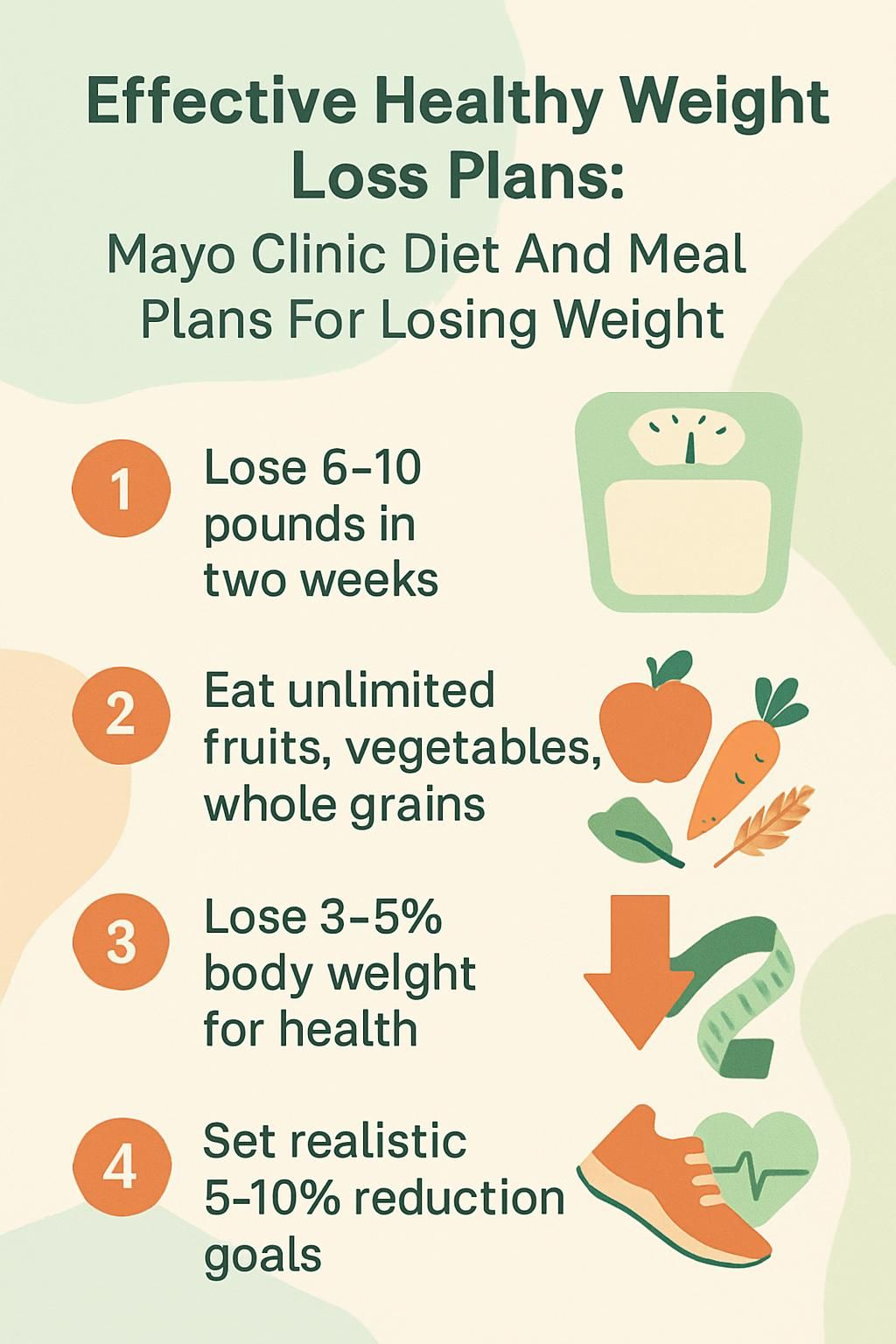Effective Healthy Weight Loss Plans: Mayo Clinic Diet And Meal Plans For Losing Weight
Our Nutrition Assistant AI Suite will transform your body. You will lose fat, get toned, and build muscle. Gain confidence and optimal health.
You may feel stuck with strict diets that do not help you lose excess weight or keep it off. A proven option like the Mayo Clinic Diet focuses on science, simple habits, and steady progress for long-term weight management.
This article shows how the plan works, what to eat, and how small daily changes lead to lasting results. Use these steps to build a healthy weight for life without feeling overwhelmed.
Key Takeaways
- The Mayo Clinic Diet uses two phases. Most people lose 6 to 10 pounds in the first two weeks, then 1 to 2 pounds per week after that.[2]
- The plan highlights unlimited fruits and vegetables, whole grains, lean proteins, and at least 30 minutes of daily movement, so you can lose weight without counting every calorie.
- Losing just 3 to 5 percent of body weight can lower the risk of type 2 diabetes, high blood pressure, high cholesterol, and heart disease.[1][2]
- Core skills include setting realistic goals, tracking progress with an app or journal, and using portion control instead of very low-calorie diets.
- Research from groups like NIH links these eating patterns and regular exercise to lower BMI, fewer cravings, better energy, and stronger long-term health.

Understanding the Mayo Clinic Diet

The Mayo Clinic Diet is a weight-loss program created by health experts. The approach centers on healthy habits that help you lose weight safely, then keep it off.
What is the Mayo Clinic Diet?
Designed by Mayo Clinic professionals, this program uses research-based strategies to guide safe, steady weight loss. It teaches skills for long-term weight control, not quick tricks.
Your daily plan follows the Mayo Clinic Healthy Weight Pyramid. The pyramid shows how to fill your plate with fruits, vegetables, whole grains, and lean proteins.
You do not need to cut out entire food groups or track every calorie. Two phases shape your journey. LOSE IT! lasts two weeks and jump-starts weight loss with quick habit changes. LIVE IT! builds lifelong behaviors for steady progress.
Unlimited fruits and vegetables make it easier to eat foods that are low in calories and high in nutrients. Online tools like planners and journals help you set goals and stay on track.
The right diet should feel like a helpful habit, not a harsh restriction.
What are the basic principles of the Mayo Clinic Diet?
The plan asks you to eat more fruits and vegetables. These foods are low in calories and high in fiber, which helps you feel full while losing weight.
At least 30 minutes of daily activity supports your metabolism and encourages a steady loss of about 1 to 2 pounds per week.
During LOSE IT!, you add five healthy habits, break five unhealthy ones, and try five bonus behaviors. One example is avoiding meals in front of the TV to prevent mindless snacking.
Portion awareness matters. You learn simple visual cues instead of strict calorie counting. In my own routine, an evening walk and swapping soda for water made these changes stick.
Next, see how this plan teaches lasting skills rather than a short-term fix.
How is it a lifestyle change instead of a temporary diet?
This program works as a lifestyle change because it trains daily routines that last. Instead of rigid rules, you practice choosing and enjoying nutrient-dense meals every day.
LIVE IT! shifts the focus to long-term choices like more fruits, vegetables, whole grains, and lean proteins, plus fewer added sugars and unhealthy fats. Research supports gradual losses of 1 to 2 pounds per week for better maintenance.
Personal goals and simple tracking guide steady progress. You replace old patterns with active living and mindful planning. Mayo Clinic experts also teach coping skills for lapses so one slip does not erase your progress.
Using these principles, I stayed near my goal weight during stressful weeks by sticking to simple pyramid-based meal plans. These habits fit into daily life and lower risks linked to obesity and chronic disease.
Next: how this plan supports lasting results and health gains.
Advantages of the Mayo Clinic Diet
This plan offers a structured, healthy diet that may help you lose weight safely and keep it off. The focus is on habits that support long-term weight management and personal health goals.
How does the Mayo Clinic Diet support lasting weight loss?
You begin with LOSE IT!, which often delivers 6 to 10 pounds lost in two weeks. Seeing quick results builds momentum and shows that healthy food choices can pay off.
Then you move to LIVE IT!, where most people average 1 to 2 pounds lost per week until they reach their goal.
Unlimited fruits and vegetables help you feel full, which makes sticking with the plan easier. Simple tracking tools add accountability and help many people stay consistent over time.
These realistic daily habits beat fad diets that are hard to maintain. They support maintenance, which is the real test of any weight-loss program.
In what ways does it improve overall health and energy?
At least 30 minutes of movement most days can lift energy and improve sleep. Choosing foods rich in fiber, vitamins, minerals, and healthy fats gives steady fuel throughout the day.
The plan encourages more fruits, vegetables, whole grains, fish, and plant-based foods. These choices can improve cholesterol numbers and may reduce risks tied to heart disease, high blood pressure, type 2 diabetes, and certain cancers.
High-fiber meals support digestion and help control hunger, which can reduce cravings. Limiting processed foods and excess sodium supports healthier blood pressure and better insulin response.
Many people with overweight report stronger energy as they follow these steps. Over time, consistent calorie control paired with nutrient-dense foods supports better brain health, muscle function, and a greater sense of well-being.
Can it reduce the risk of chronic diseases?
Beyond day-to-day energy, the Mayo Clinic Diet can lower risks for conditions like diabetes, heart disease, high blood pressure, and sleep apnea.
Losing 3 to 5 percent of your body weight can improve triglycerides and blood glucose. Losses above that range are linked to lower blood pressure and LDL and higher HDL.
Waist size matters too. Over 35 inches for women or 40 inches for men raises the risk of heart attack or stroke.
In my family, adding more plants and using guidance from the National Institute of Diabetes and Digestive and Kidney Diseases helped both my parents trim several inches off their waists in six months. Their follow-up labs showed better lipid profiles.
Focus on fiber-rich foods like vegetables, fruits, whole grains, and legumes. Limit sodium to protect blood pressure. Eating patterns similar to the Mediterranean or DASH diets are linked to fewer cases of high cholesterol and some cancers in clinical nutrition studies.
Regular movement lowers risks related to obesity as well. You do not need surgery or extreme low-calorie plans. Small, steady changes add up.
How does it encourage healthy eating habits?
Unlimited fruits and vegetables fill your plate with fiber and key nutrients. Whole grains, legumes, nuts, fish, and healthy oils are everyday staples.
You do not have to count every calorie or cut entire food groups. The approach can fit vegetarian or flexible eating styles.
You swap processed snacks for simple options like fruit or whole grain crackers. The Healthy Weight Pyramid guides portions and variety.
When I traded chips for carrots and hummus at lunch, I stayed full longer without extra calories. Most people notice fewer sugar cravings after a few weeks.
Next comes portion awareness, which makes weight loss safer and more successful.
How to Follow the Mayo Clinic Diet
Use the Mayo Clinic Healthy Weight Pyramid to shape your meals. Planning ahead helps you build healthy eating habits that support both health and weight loss.
What is the Healthy Weight Pyramid and how is it used?
The pyramid helps you choose foods that support losing weight and keeping it off. The base includes unlimited fruits and vegetables, which are low in calories and high in fiber.
Above that sit grains, with a focus on whole grains and smart portions. Next come lean proteins like poultry, fish, beans, and lower fat dairy.
These give needed nutrients without too much saturated fat. Fats and sweets sit at the top as foods to limit.
The pyramid teaches balance and moderation, not extreme restrictions. You use it to plan meals that are filling and lower in added sugars and sodium.
Variety matters. A mix of foods provides vitamins like vitamin D, plus fiber and antioxidants that support heart and metabolic health.
Why are portion sizes important on this diet?
Portion awareness helps you manage calories without strict counting. The Mayo Clinic Diet teaches visual cues, like comparing servings to your hand or everyday objects. These simple checks help you eat the amount you need.
This skill fits real life and supports steady loss. Even healthy foods can slow progress if portions are too large.
Smaller plates and bowls often reduce intake. I started measuring nuts before snacking, which stopped overeating on busy days.
With practice, portion control becomes automatic. Next, see how to add daily activity in a practical way.
How can you incorporate physical activity daily?
Daily movement supports weight loss and energy. The Mayo Clinic Diet suggests at least 30 minutes most days. Spread it out if needed.
- Walk briskly for 30 minutes daily. Use a step counter or phone app for motivation.
- Choose stairs over elevators in public places to add quick bursts of effort.
- Take short movement breaks during work. Stretch, stand, or do light chair exercises.
- For short errands, walk or bike instead of driving when possible.
- Join group classes like yoga or dance. A social setting can improve consistency.
- Use resistance bands while watching TV to add light strength work.
- Make chores active. Garden, mop floors, or wash the car by hand.
- Play active games with kids. Everyone benefits, and it sets a positive example.
- Once you feel stronger, increase time or intensity for extra heart benefits.
- Track your activity in a log or app to stay accountable over time.
Walking after meals helped me manage cravings and stay upbeat without any special gear or a gym.
What Makes a Weight Loss Plan Effective?
Clear goals and balanced nutrition support real change. Plans like the Mayo Clinic Diet build healthy habits so you can lose weight and keep it off.
How do you set realistic weight loss goals?
Set goals that are specific and measurable. Aim to lose 1 to 2 pounds per week. Health experts suggest this pace because it supports long-term success.
Target a 5 to 10 percent loss over six months. Even a 3 to 5 percent drop can reduce risk for serious health problems.
Start by tracking food and activity with a simple app or paper journal. Break big goals into smaller steps and focus on habit changes you can sustain.
Choose an eating style centered on nutritious whole foods. Plans like the Mediterranean or MIND styles emphasize quality and variety, not meal replacement shakes alone.
What is a calorie deficit and how do you create one?
A calorie deficit means you eat fewer calories than your body uses each day. A daily deficit of 500 to 1,000 calories usually leads to steady weight loss.
As a general guide, the Mayo Clinic Diet often places women between 1,200 and 1,500 calories per day and men between 1,500 and 1,800. Needs vary by size, age, and activity level. Very low-calorie diets near 800 calories require medical supervision.
Track what you eat to see patterns. Choose nutrient-dense foods from the pyramid. Add activity to increase energy burn.
I cut out sugary drinks and added a 30-minute walk most days. The change felt doable, and results showed up within a few weeks.
Why choose nutrient-rich foods for weight loss?
Once you create a calorie deficit, nutrient-dense foods keep you satisfied and healthy. Vegetables, fruits, whole grains, legumes, nuts, and fish supply the vitamins, minerals, and fiber your body needs.
The Mayo Clinic Diet favors these foods because they fill you up with fewer calories. Mediterranean-style eating adds healthy fats from olive oil and fish while limiting ultra-processed items. Higher protein can also protect muscle during weight loss.
This approach lowers risks linked to chronic disease. Choosing whole foods helps you avoid excess sodium and unhealthy fats found in many packaged items.
After I shifted to meals rich in greens, beans, and lean proteins, my energy stayed steady. Progress felt consistent instead of up and down.
Nutrient-dense eating supports both weight control and long-term wellness better than crash diets.
Nutritional Guidelines of the Mayo Clinic Diet
The Mayo Clinic Diet uses simple nutrition rules to support safe weight loss, lower harmful oxidative stress, and protect overall health.
Which fruits, vegetables, whole grains, and lean proteins are recommended?
You need a variety of foods for healthy weight loss. The plan highlights nutrient-dense choices that support your health.
- Choose fruits like berries, apples, pears, oranges, grapes, and kiwi. These provide antioxidants that fight free radicals.
- Fill meals with vegetables such as spinach, kale, carrots, broccoli, and tomatoes for key vitamins and minerals.
- Pick whole grains for steady energy, for example brown rice, quinoa, oats, and 100 percent whole-wheat bread.
- Use lean proteins including skinless chicken breast, fish like salmon or sardines, beans, lentils, and nuts.
- Limit red meat. Plant-based proteins work well if you prefer a vegetarian or vegan approach.
- Include low-fat dairy like Greek yogurt or skim milk unless you avoid dairy due to intolerance or preference.
- Drink water throughout the day to support hydration and appetite control.
Next, see which foods to limit for better progress.
What foods should be limited or avoided?
Some foods can slow your progress on the Mayo Clinic Diet. Limit or avoid the following.
- Sugary drinks add empty calories and spike blood sugar. Cut back on soda, energy drinks, and juice.
- Highly processed snacks like chips and instant noodles are often high in sodium, added sugars, and unhealthy fats.
- Foods high in saturated and trans fats include fried items, certain baked goods, and processed meats. Reducing these supports heart health.
- Candy, pastries, and doughnuts add calories fast with little nutrition. The plan allows about 75 dessert calories a day, so use them wisely.
- Refined grains like white bread and white rice lack fiber. Swapping to whole grains supports fullness.
- Full-fat dairy adds extra saturated fat. Choose low-fat or fat-free versions.
- Fast food often combines unhealthy fats and large portions. Favor homemade meals or healthier restaurant choices.
- Alcohol adds calories without many nutrients. Keep intake low as part of a healthy plan.
Following these steps gave me more energy within two weeks compared with earlier fad diets I tried. Getting guidance from my provider helped me personalize the plan.
How important is hydration during weight loss?
Hydration plays a key role in every weight loss plan. Drinking water before meals can increase fullness and reduce calorie intake.[1] Your body also needs fluids to burn calories well during activity and daily tasks.
Staying hydrated helps muscles work better and reduces fatigue. Even mild dehydration can affect performance. Mayo Clinic guidance encourages water as your main beverage, which fits the lifestyle focus of this diet.[2]
Up next are examples of fruits, vegetables, whole grains, and lean proteins that fit the plan.
…
[1] Dennis EA et al., “Water consumption increases weight loss during a hypocaloric diet intervention in middle-aged and older adults,” Obesity (Silver Spring), 2010.
[2] Mayo Clinic Staff, “Mayo Clinic Diet: What is your goal?” Mayoclinic.org
Sample Meal Plans for the Mayo Clinic Diet
The Mayo Clinic Diet includes practical meal ideas that support healthy weight loss and daily nutrition. The goal is balance at every meal.
What are healthy breakfast options?
A solid breakfast helps you stay full and energized. These options follow the plan’s principles.
- Overnight oats with fresh berries and sliced pear deliver fiber and slow-burning carbs.
- Whole grain toast with avocado provides healthy fats and complex carbohydrates.
- Low-fat Greek yogurt with chopped apples or bananas adds protein and calcium.
- Scrambled eggs with spinach or tomatoes supply protein and antioxidants.
- A smoothie with kale, frozen berries, and low-fat milk offers nutrients in a quick meal.
- Steel-cut oatmeal with walnuts supports heart health and steady energy.
- Cottage cheese with pineapple offers a light, satisfying option.
- Choosing fruit instead of pastries trims calories and boosts fiber.
- Drink water with breakfast to support metabolism and hydration.
Next, build a lunch that keeps you satisfied through the afternoon.
What can you eat for lunch on this diet?
Lunches that combine lean protein, vegetables, and whole grains help you meet your goals.
- Tuscan white bean soup with a light pesto drizzle gives fiber and healthy fats.
- Grilled chicken breast or salmon keeps you fuller longer and protects muscle.
- Add quinoa or brown rice for sustained energy and key minerals.
- Include vegetables like spinach, carrots, or broccoli for antioxidants and fiber.
- Swap refined grains for whole foods. Skip sugary drinks to manage calories.
- Choose water or unsweetened green tea to stay hydrated.
- If you use intermittent fasting, place lunch within your eating window while keeping balance.
- For afternoon cravings, try a protein or fiber snack. Greek yogurt with berries works well.
- Consult a health professional if you have questions or medical conditions that affect your diet.
When I chose hearty bean soups at lunch, I avoided mindless snacking and stayed focused through the day.
What are nutritious dinner ideas?
Dinner should be satisfying and simple. Aim for lean protein, vegetables, and smart portions.
- Sheet-pan roast chicken with broccolini, onion, and tomatoes makes a balanced plate.
- Grilled salmon with steamed brown rice and roasted carrots supplies protein and omega-3 fats.
- Turkey chili with low-sodium beans and peppers is hearty and filling.
- Stir-fried tofu or shrimp with bell peppers, snow peas, and mushrooms over quinoa fits the pyramid.
- Baked cod or tilapia with asparagus and sweet potatoes uses olive oil sparingly.
- Big salad with greens, tomatoes, cucumbers, chickpeas, avocado, and grilled chicken. Use a light vinaigrette.
- Low-carb option: cauliflower rice topped with sautéed spinach and grilled turkey cutlets.
Daily movement can enhance the benefits of these dinners by supporting metabolism and sleep quality.
What snacks fit well with the Mayo Clinic Diet?
Smart snacks manage hunger and help you stay consistent between meals.
- Choose fruits and vegetables most often. For example, a cup of sliced peppers with a banana.
- Pick whole fruits over juice to get more fiber and fewer added sugars.
- Keep snacks around 100 to 200 calories. Check labels or use an app.
- Avoid fried snacks and candy, which do not fit the plan’s goals.
- Drink water with your snack to support fullness.
- Include lean protein when you need staying power, like a hard-boiled egg or low-fat yogurt.
- Plan snack times so hunger does not build too much between meals.
- Use Mayo Clinic resources for new snack ideas that match your needs.
Prepping veggie sticks on Sunday helped me skip the vending machine during busy workdays.
Physical Activity and Weight Loss
Physical activity burns calories, supports weight loss plans, and boosts motivation.
What exercises are best for beginners?
Start with low-impact activities that feel comfortable. Walking, cycling, swimming, and dancing work for most beginners. The Mayo Clinic suggests at least 150 minutes of moderate or 75 minutes of vigorous weekly exercise.
Build up slowly to avoid burnout or injury. I started with brisk walks, which felt doable and kept me consistent.
Pick activities that match your fitness level and health status so you can progress safely.
How do you balance strength training with cardio?
Combining both types of exercise helps with fat loss and muscle maintenance. Here is a simple plan.
- Do strength training 2 to 3 times per week to build muscle and support metabolism.
- Add cardio on most other days to burn calories and improve heart health.
- Alternate days, or combine shorter sessions if your schedule is tight.
- Focus on good form to prevent injury and see results faster.
- Get guidance from a trainer if you are unsure where to start.
- Mix brisk walking or cycling with bodyweight or resistance band moves.
- Track sessions weekly to see how balance supports steady progress.
Using both styles made me feel more energetic. It also made the Mayo Clinic Diet easier to follow long term.
What are the metabolic benefits of regular exercise?
Exercise increases the number of calories you burn during and after activity, which helps you create and maintain a calorie deficit. It also lowers risks tied to obesity, such as diabetes and heart disease.
Regular movement steadies blood sugar and supports heart function. Since needs differ, talk with a healthcare professional before starting a new routine if you have medical concerns.
How to Overcome Challenges in Weight Loss
Most people face obstacles on the way to a healthy weight. The right strategies and support make progress possible.
How can you manage food cravings effectively?
Keep fruits and vegetables handy to satisfy cravings with fewer calories. Sliced carrots, apples, or celery give volume and crunch without a large calorie load.
If stress pushes you toward chips or sweets, try water, tea, or a short walk instead. These quick actions break old patterns.
Use tools from the plan, such as a food journal or an online community, to stay motivated. Replacing less healthy snacks with nutrient-dense options helps you stick with your goals.
What strategies help maintain consistency with the diet?
Use simple trackers or apps to log meals and activity. These tools help you set reminders and notice patterns.
Choose realistic goals. Weigh yourself weekly to watch the trend, not daily changes. Check in with a dietitian or healthcare provider for support and accountability.
These steps reduce stress and make long-term consistency more likely.
How do you handle social situations and eating out?
This plan is flexible, which helps in social settings. Look for grilled proteins, vegetables, and salads on the menu. Portion control lets you enjoy the occasion while staying on track.
Ask for sauces and dressings on the side. Try to fill half your plate with vegetables or fruit. I sometimes bring a small snack to family gatherings, which helps me avoid overeating later.
Simple adjustments like these keep you consistent without making events stressful.
What Results Can You Expect with the Mayo Clinic Diet?
This plan aims for steady progress and practical habits that last.
How quickly can you see weight loss results?
Many people see results in the first two weeks during LOSE IT!, often 6 to 10 pounds lost. Early progress can boost confidence and commitment.
During LIVE IT!, expect about 1 to 2 pounds per week until you reach your goal. Faster plans often do not support long-term maintenance as well as steady, evidence-based approaches.
As weight changes, health markers usually improve too.
What health improvements are typical?
Losing 3 to 5 percent of body weight can lower triglycerides and improve blood glucose. These changes can reduce the risk of diabetes.
Greater losses can lead to lower blood pressure and improved LDL and HDL cholesterol. Many people also notice better energy and focus.
These gains support long-term health and quality of life.
How do you maintain your weight after reaching your goals?
Keep using the LIVE IT! habits. Focus on nutrient-dense foods, practice portion control, and build daily activity into your routine.
Track meals and weigh in regularly to catch small gains early. If you slip, use problem-solving steps from Mayo Clinic materials to reset quickly.
For me, a short evening walk and simple weekly meal planning kept my weight stable for more than two years.
Risks and Precautions
Think about your health history before starting any new plan. This information is educational and is not medical advice.
What health concerns should you consider before starting?
Sudden diet changes can cause gas or other digestive issues as fiber increases. Large amounts of fruit can raise blood sugar and triglycerides in people with diabetes or high cholesterol.
Rapid weight loss may reduce muscle and water instead of body fat. It can also raise the risk of gallstones, gout flares, fatigue, constipation, diarrhea, or nausea.
Plans that are not adjusted for your health status can increase these risks. Talking with a healthcare provider first is wise, especially if you have chronic conditions.
When should you consult a healthcare professional?
Check with a healthcare professional before starting any weight-loss plan if you have medical conditions, take prescription drugs, or manage diabetes. People considering very low-calorie diets should only do so with medical supervision.
Children, teens, pregnant people, and older adults should get provider approval before significant changes. I once changed my eating fast after college and felt tired all day. A quick visit found a small issue that needed attention.
Ask for guidance if you feel unsure about what is safe for your age or health.
Getting Started with the Mayo Clinic Diet
You can begin with official guides, simple tools, and supportive coaching if you want extra help.
Where can you find official Mayo Clinic resources?
Look for Mayo Clinic Diet books and FAQs. They include step-by-step guidance, sample meal plans, and strategies based on sound evidence.
Visit the official Mayo Clinic website for materials. You can also schedule appointments at locations in Arizona, Florida, Minnesota, or within their Health System network.
Use the online BMI calculator or the Mayo Clinic Diet iPhone app to track progress. I found the app helpful for daily accountability.
How do you track progress and stay motivated?
Tracking keeps you focused and encourages steady effort. Try these steps.
- Use the Mayo Clinic food and exercise journal to log meals and activity.
- Weigh in weekly with a digital scale. Enter results into a tracker.
- Measure your waist and other areas weekly to see changes beyond the scale.
- Set short-term goals, like 1 to 2 pounds per week or 30 minutes of daily walking.
- Join the Mayo Clinic email list for tips and encouragement.
- Celebrate small wins with non-food rewards, such as a book or time for a hobby.
- Connect with online communities for advice and accountability.
- Place visual reminders of your goals where you will see them often.
- Review what worked each week and adjust plans to remove barriers.
These steps prepare you to use community or professional support when you need it.
What support options are available from communities or professionals?
Support makes change easier. You can choose from these options.
- Dietitian Support: A registered dietitian can review your habits and give evidence-based suggestions. The Academy of Nutrition and Dietetics lists licensed experts in many areas.
- Mayo Clinic Programs: The official site offers digital tools, recipes, meal plans, and coaching options.
- Healthcare Provider Guidance: Doctors can advise you if you have chronic conditions like diabetes or heart disease. Some people need medical supervision.
- Online Weight Loss Communities: Forums and social media groups offer shared tips, accountability, and encouragement.
- NHLBI Resources: The “Aim for a Healthy Weight” program teaches goal setting and calorie tracking.
- App-Based Tools: Many apps include reminders, expert feedback, peer chats, and progress dashboards.
- Local Fitness Centers: Beginner-friendly classes match well with healthy eating plans and add social support.
- Counseling Services: Professionals can help with stress or emotional eating if these are barriers.
I joined an online group after my doctor’s advice in 2023. Weekly check-ins kept me focused on meal planning during busy school weeks.
Conclusion
The Mayo Clinic Diet helps you build healthy weight loss plans you can live with. You learn simple habits that support steady results, higher energy, and better health.
The Healthy Weight Pyramid makes food choices clear and flexible. Many people report better mood and confidence once these routines become daily life.
Use expert resources and support to stay motivated. This evidence-based plan provides a strong path for long-term weight management and a healthier lifestyle. For medical questions or special health conditions, talk with a qualified healthcare professional before you start.
FAQs
1. What makes the Mayo Clinic Diet effective for healthy weight loss?
The Mayo Clinic Diet uses a plan tailored to your needs, focusing on balanced nutrition and sustainable habits. Research shows that personalized meal plans help people lose weight and keep it off.
2. How do meal plans from the Mayo Clinic support losing weight?
Meal plans designed by the Mayo Clinic use evidence-based guidelines to match your health goals. These plans include proper portions, nutrient-rich foods, and calorie control tailored to your needs.
3. Can a diet plan be adjusted for different lifestyles or medical conditions?
Yes, an effective healthy weight loss plan should be tailored to your needs. The Mayo Clinic approach allows adjustments based on age, activity level, or medical history so each person can follow a safe path toward their goal.
4. Why is it important for a diet plan to be personalized?
A plan tailored to your needs increases success because it fits with daily routines and preferences. Studies show that customized diets improve adherence rates compared with generic programs.
Summary: Personalized approaches like those from the Mayo Clinic offer practical solutions backed by research; they focus on individual requirements for lasting results in healthy weight loss efforts.







